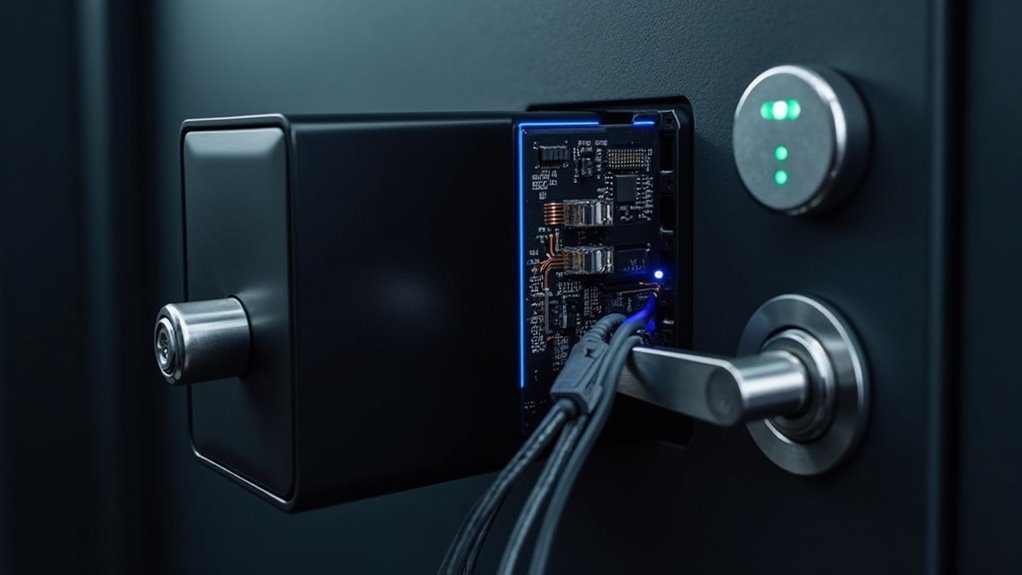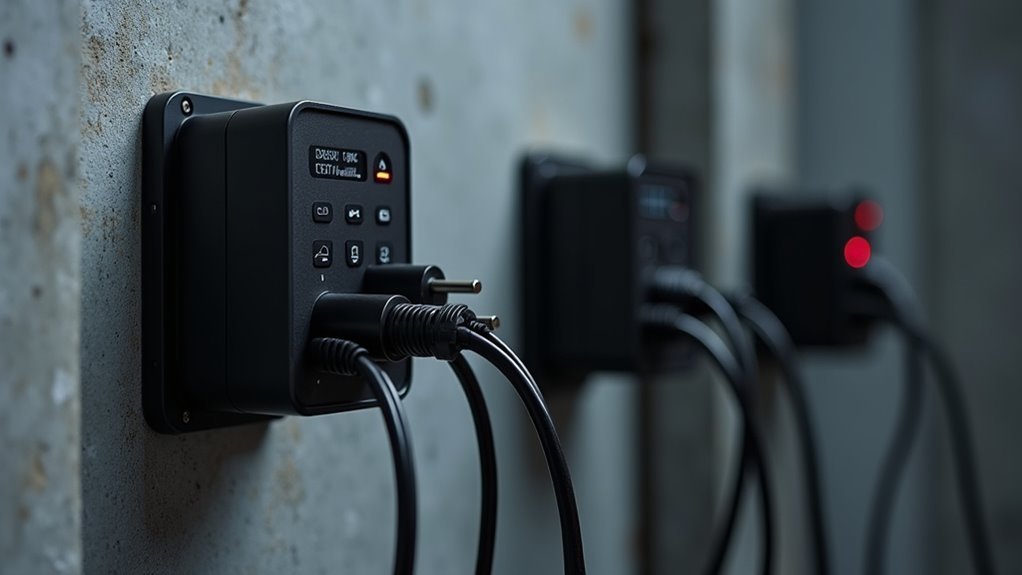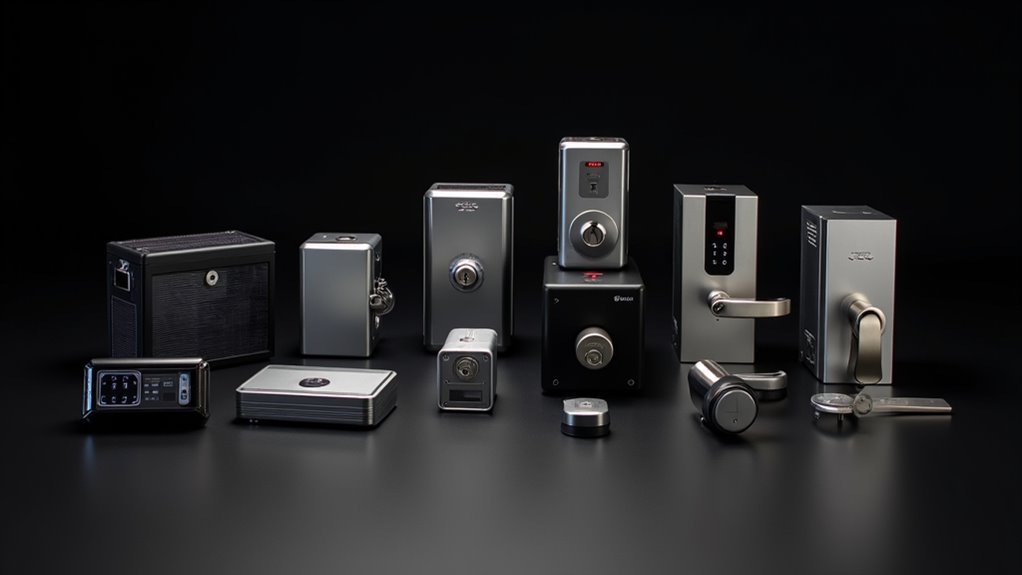You’re probably familiar with the frustration of a dead smart lock battery at the worst possible moment. Whether you’re managing a single home entry point or overseeing an entire commercial security network, power failures can compromise your access control systems when you need them most. The right backup solution isn’t just about keeping doors functional—it’s about maintaining security protocols and ensuring you’re never locked out of your own property.
Battery-Powered UPS Systems for Smart Lock Networks

When power outages strike, battery-powered UPS systems serve as your first line of defense for maintaining smart lock networks.
These uninterruptible power supply units guarantee your security systems remain operational when grid power fails, providing critical access control continuity.
These backup power units ensure your security systems stay active during grid failures, maintaining essential access control operations.
You’ll benefit from automatic voltage regulation features that protect sensitive electronics from damaging power surges.
Most battery backup systems can sustain smart locks for several hours, giving you peace of mind during extended outages.
Many models include multiple battery-backed outlets, allowing you to power additional security devices like cameras and alarms simultaneously.
Choose a UPS with user-replaceable batteries to minimize maintenance costs and downtime.
This reliable power source becomes essential for thorough security system protection, guaranteeing your smart locks never compromise building access when you need it most.
Solar-Powered Backup Solutions for Door Access Controls
Beyond traditional UPS systems, solar-powered backup solutions offer a sustainable approach to keeping your door access controls operational during outages. These systems use solar panels to continuously charge a backup battery, ensuring your security systems remain functional even in remote locations.
| Component | Function |
|---|---|
| Solar Panels | Convert sunlight to electricity for continuous charging |
| Backup Battery | Stores energy for extended operation during power outages |
| Charge Controller | Regulates power flow and prevents overcharging |
| Inverter | Converts DC power to AC for access control devices |
| Monitoring System | Tracks performance and battery status |
You’ll need to position solar panels for maximum sunlight exposure to maintain ideal charging. These eco-friendly solutions work perfectly for keypads, card readers, and electronic locks in off-grid installations.
Portable Power Stations for Multi-Lock Security Systems

For complex security installations requiring multiple access points, portable power stations deliver scalable backup solutions that can simultaneously support numerous lock systems.
The EcoFlow DELTA Max powers up to thirteen devices at once, making it perfect for multi-lock configurations. With capacities ranging from 882Wh to 3600Wh, these units provide reliable power supply during outages, ensuring your security systems stay operational when you need them most.
You’ll appreciate the rapid charging capabilities—the DELTA Pro reaches full charge in just two hours. Many models support solar charging, giving you sustainable backup power options.
At only 23.6 lbs, these portable power stations are easily transportable for temporary deployments. This mobility lets you quickly respond to power emergencies across different lock system locations.
Built-in Rechargeable Battery Options for Smart Locks
Smart locks with built-in rechargeable battery options offer the most streamlined power backup solution, eliminating the need for external power sources or frequent battery replacements.
These security systems typically feature 2000mAh to 4000mAh batteries that provide power for several months, ensuring your lock continues functioning during outages. You’ll receive low-battery alerts before depletion, preventing unexpected lockouts that could compromise your security.
Most models support USB charging, letting you recharge without removing the lock from installation.
With lifespans of 1-3 years depending on usage, these batteries keep your security reliable over time. The built-in design streamlines your setup while maintaining consistent protection, making this the most convenient power backup option for individual smart locks.
Generator-Based Power Backup for Commercial Lock Systems

When you’re considering generator-based power backup for your commercial lock systems, you’ll need to evaluate specific installation requirements for standby units that can integrate directly with your property’s electrical infrastructure.
Your generator’s fuel source management becomes critical since you’ll want automated refueling capabilities through natural gas or propane connections to maintain continuous operation during extended outages.
You should plan for the upfront investment of $7,000 to $15,000 plus installation costs, but this guarantees your access control systems won’t experience downtime when power failures occur.
Standby Generator Installation Requirements
Installing a standby generator for commercial lock systems requires careful planning and adherence to specific technical requirements.
You’ll need to establish a concrete slab foundation for stability and connect your standby generators to a reliable fuel source like natural gas or propane. The installation process involves integrating a transfer switch that automatically activates the generator during power failures, seamlessly maintaining your lock systems’ operation.
You must calculate the proper power output based on your commercial lock systems’ total wattage requirements plus any additional critical loads.
Before beginning installation, obtain necessary permits to comply with local building codes and regulations.
Regular maintenance schedules including routine inspections and fuel checks guarantee your generator performs reliably when protecting your security infrastructure during outages.
Fuel Source Management
Effective fuel source management determines the long-term success and cost-efficiency of your generator-based power backup system.
You’ll need to choose between natural gas, propane, or diesel based on availability and cost considerations in your area. Natural gas offers convenience through existing utility connections, while propane and diesel require tank refueling schedules you must maintain.
Your ongoing fuel expenses considerably impact operational costs, so you’ll want to monitor consumption patterns and negotiate favorable fuel contracts. Diesel typically provides the highest energy density but requires more frequent maintenance. Propane burns cleaner but costs more per BTU. Natural gas delivers reliable power at consistent pricing but depends on utility infrastructure.
Regular fuel supply checks guarantee your system provides uninterrupted security during extended outages.
Capacitor-Based Emergency Power for Electronic Deadbolts
Although traditional battery backup systems have dominated emergency power solutions, capacitor-based emergency power offers superior reliability for your electronic deadbolts.
These systems provide short-term power during outages, keeping your locks operational for several hours when you need them most.
You’ll appreciate how quickly capacitor-based systems recharge—often within seconds compared to lengthy battery charging cycles. This means your power supply returns to full capacity immediately after interruptions.
Your electronic deadbolts will benefit from capacitors’ impressive 10-year lifespan, far exceeding traditional batteries that degrade over time.
The compact design integrates seamlessly into existing lock hardware without major modifications.
Unlike battery alternatives, capacitors perform consistently across extreme temperature ranges, ensuring your security system remains dependable regardless of environmental conditions.
Power Over Ethernet (PoE) Backup Systems for Connected Locks
When you’re managing connected lock systems, you’ll find that PoE backup solutions offer three distinct approaches to maintaining power during outages.
You can implement PoE switch battery backup units that keep individual switches running, integrate UPS systems directly with your network switches, or deploy centralized power management systems that coordinate backup power across multiple devices.
Each method provides different levels of coverage and control, so you’ll need to match your choice with your specific security requirements and network architecture.
PoE Switch Battery Backup
Power over Ethernet (PoE) switches revolutionize lock system deployments by delivering both power and data through a single cable, eliminating the need for separate electrical connections at each lock location.
When you’re designing robust security systems, PoE battery backup solutions guarantee your locks remain operational during power outages without requiring individual backup units.
You’ll want to select switches supporting IEEE 802.3af or 802.3at standards for ideal compatibility with various PoE-enabled locks.
These systems feature automatic switchover capabilities, providing seamless changeover from main power supply to battery power when outages occur.
Calculate your total wattage requirements carefully, as connected devices’ power consumption directly affects runtime.
This calculation guarantees you choose an appropriately sized backup solution that maintains security coverage throughout extended outages.
Network Switch UPS Integration
Building upon PoE switch battery backup concepts, integrating an uninterruptible power supply (UPS) with your network switches creates a centralized protection strategy that safeguards all connected PoE devices simultaneously.
Your UPS integration offers several advantages for security systems:
- Runtime Calculation: A 300W load runs approximately 21 minutes on a 1,350 VA UPS, giving you predictable backup duration.
- Automatic Voltage Regulation: Modern UPS units include AVR features that protect your sensitive network equipment from power fluctuations.
- Continuous Operation: Connected smart locks maintain functionality during outages, preventing unauthorized access vulnerabilities.
This power supply solution eliminates single points of failure in your security infrastructure.
You’ll maintain complete access control even when grid power fails, ensuring your PoE-powered locks continue operating seamlessly while protecting against both outages and voltage irregularities.
Centralized Power Management Systems
Since modern access control demands both reliability and scalability, centralized Power Management Systems using PoE technology deliver the backbone your security infrastructure needs.
These systems transmit both power and data through single cables, eliminating costly electrical wiring while simplifying installations.
When integrated with UPS systems, PoE backup solutions guarantee your connected locks maintain operation during outages.
You’ll benefit from seamless power continuity that keeps multiple access points secure simultaneously.
The centralized approach lets you monitor battery status and power consumption remotely, enabling proactive maintenance before failures occur.
You’ll reduce installation costs considerably while enhancing your security systems’ reliability.
Multiple devices operate from one centralized power source, creating an efficient infrastructure that scales with your needs without requiring additional outlets or complex wiring modifications.
Wireless Power Banks for Keypad Entry Systems
When power outages strike, you’ll find that wireless power banks offer an exceptionally portable and convenient backup solution for your keypad entry systems. These compact devices serve as a reliable backup power source, ensuring continued access when the main power fails.
Most wireless power banks feature USB outputs that’ll directly charge your keypad entry systems supporting USB connections. Here’s what makes them particularly effective:
- Substantial capacity – Ranging from 10,000mAh to 30,000mAh, providing several hours of backup power
- Built-in surge protection – Safeguards your systems against dangerous voltage spikes during outages
- Easy installation – Lightweight design allows simple placement near entry points without permanent setup
You can install these versatile units quickly without extensive modifications, making them ideal for both residential and commercial applications.
Hybrid Solar-Battery Combinations for Gate Lock Systems
When you’re securing gates and outdoor entry points, hybrid solar-battery combinations offer the most sustainable power backup solution available.
You’ll benefit from solar panels that continuously recharge your system during daylight hours, eliminating dependence on grid power while maintaining 24/7 operation.
Your battery capacity needs will determine how long your gate locks can function during extended cloudy periods or power outages.
Solar Panel Integration Benefits
As energy costs continue rising and power outages become more frequent, hybrid solar-battery combinations offer an innovative solution that transforms your gate lock system into a self-sustaining security fortress.
Solar panels harness renewable energy during daylight hours, automatically recharging your battery backups to maintain reliable power supply for continuous access control operations.
Your system gains multiple advantages through this integration:
- Cost reduction – You’ll slash electricity bills by storing solar energy for peak-hour usage and emergency situations
- Environmental sustainability – You’re reducing fossil fuel dependence while maintaining robust security infrastructure
- Enhanced reliability – Your gate locks operate flawlessly during outages, especially in remote locations with unreliable grid connections
This technology guarantees uninterrupted security functionality while delivering long-term economic benefits through reduced operational costs.
Battery Capacity Requirements
Building an effective hybrid solar-battery system starts with selecting the right battery capacity to match your gate lock’s power demands and operational requirements.
You’ll need a minimum of 100 to 200 amp-hours to guarantee reliable operation during extended power outages. Since electric gate locks typically draw 2 to 5 amps during operation, a 12V battery capacity provides sufficient power supply for most residential and commercial applications.
For critical security systems, you should plan for backup duration of 24 to 48 hours without sunlight. This guarantees your gate locks remain functional during prolonged outages.
Match your solar panel array to your battery capacity, aiming for 300 to 400 watts of solar power for ideal charging efficiency and system reliability.
Emergency Power Packs for Biometric Door Locks
Power outages shouldn’t compromise your home’s security when you’ve invested in biometric door locks.
Emergency power packs provide reliable backup power specifically designed for these systems, using rechargeable lithium-ion batteries that deliver several hours of continuous operation. These portable power station units automatically recharge through AC outlets or solar panels, guaranteeing constant readiness.
Key benefits of emergency power packs include:
- Multi-device charging – USB ports let you power additional devices during emergencies
- Smart monitoring – Low battery indicators alert you when charging or replacement is needed
- Compact design – Easy storage and quick deployment during power failures
You’ll find these backup power solutions offer peace of mind while maintaining your biometric door locks’ functionality.
Their compact, portable design assures you can quickly restore security access whenever electrical outages occur.
Frequently Asked Questions
What Is the Best Backup Power Source?
You’ll find uninterruptible power supplies work best for backup power since they provide immediate electricity during outages while protecting against surges. They’re reliable, cost-effective, and guarantee your systems stay running continuously.
What Is the Alternative to a Generator for a Power Outage?
You can choose home battery backup systems like Tesla Powerwall, portable power stations such as EcoFlow DELTA, or UPS units that’ll provide clean, quiet power without generator noise and emissions.
Which UPS Gives 4 Hours Backup?
You’ll get 4 hours backup from the CyberPower CP900AVR for Wi-Fi networks or the CP1350AVRLCD3 at 20W loads. You’ll need higher-capacity UPS models with efficient power management for extended runtimes.
How to Power Your Home Through an Outage Without a Gas Generator?
You can power your home during outages using battery systems like Tesla Powerwall, solar-powered backup solutions, or portable power stations. These gas-free alternatives store energy and maintain electricity for essential devices.





Leave a Reply